The Los Angeles Philharmonic through the years

Nearly a century ago, founder W.A. Clark Jr. (standing with the first iteration of his orchestra above, center left) announced that the Los Angeles Philharmonic “shall grow to be the best in the United States.” The L.A. Philharmonic’s trajectory is far from straight and simple, but each step played a part in where the orchestra stands today. Scroll through our multimedia timeline to read about financial struggles and sudden resignations, as well as trailblazing collaborations, and find video and audio from key performances.
An orchestra is born

Official talks to form the Los Angeles Philharmonic begin, headed by millionaire William Andrews Clark Jr. Promising better wages with his $200,000 sponsorship, Clark draws in 90 players, including first-chair talent from the East Coast.
Clark, the son of a copper mogul and a lover of the arts, once studied violin in Paris.
First conductor comes to town

Eventual music director Walter Henry Rothwell arrives from New York.
Rothwell, an English import who served as an apprentice to Gustav Mahler for two years, was W.A. Clark Jr.’s second choice. Clark had originally set his hopes on Sergei Rachmaninoff, who, having recently moved to New York from Oslo, declined to visit.
A new era in L.A. music history

The L.A. Philharmonic debuts at the Trinity Auditorium downtown, with a program that includes Antonín Dvořák’s “New World Symphony” and Franz Liszt’s “Les Preludes.”
A review of the concert in the L.A. Times notes the orchestra’s impressive size and lauds Walter Henry Rothwell’s performance: “Rothwell … yesterday startled Los Angeles out of her symphonic slumbers and introduced what might be termed a new epoch in local musical history.”
The Philharmonic changes nests

Second-season rehearsals begin in Clune Auditorium with Tchaikovsky’s Fifth Symphony. Founder W.A. Clark Jr. secured the performance space because of its much larger audience capacity compared to the Trinity Auditorium (an increase from about 2,300 seats to 3,000).
The theater, which was quickly renamed the Philharmonic Auditorium, will become the orchestra’s home for 44 years.
The Philharmonic takes on the Bowl
Guest conductor Alfred Hertz and the L.A. Phil kick off concerts in the Hollywood Bowl with pieces by Wagner, Brahms, Grieg and Rossini.
The three-year-old venue, a popular picnic spot known as Daisy Dell until the Theatre Arts Alliance purchased the land for $47,500, consists of movable wooden benches and a temporary stage until 1926.

A maestra takes the dais

Guest conductor Ethel Leginska is the first woman to lead the L.A. Philharmonic.
Leginska’s program at the Hollywood Bowl opens with Weber’s “Oberon,” and includes Beethoven’s Seventh and “Six Little Songs,” a collection of her own arrangements of Mother Goose rhymes.
Thousands witness unveiling of remodeled Bowl

About 20,000 people watch the Hollywood Bowl dedication concert from new, permanent seats. The amphitheater space, deepened and filled with a concrete foundation featuring long aisles and pathways, wraps around an enlarged stage. These improvements mark the first $100,000 of a million-dollar improvement plan.
The first rendition of the venue’s iconic proscenium shell, designed by Allied Architects, is built but torn down at the end of the season because of acoustical issues.
Click below to see footage of workers installing new benches at the Bowl:
Rothwell dies at 55; Schnéevoigt takes over

Conductor Georg Schnéevoigt arrives to fill a void left by Walter Henry Rothwell, whose eight-year tenure ended when he died of a heart attack while driving to Santa Monica.
The Finnish music director resigns two years later to pursue other conducting engagements. Read the L.A. Times review of his first concert with the orchestra.
The L.A. Phil enters homes via phonograph
The earliest recording of the L.A. Phil is made by the Victor Talking Machine Co., the first of several that would be released in a 78 rpm album called “A Hollywood Bowl Concert — Symphonies Under the Stars.” It was the first commercial recording made by a symphony outdoors, conducted by guest Eugene Goossens.
Three microphones, each with an amplifier used to transfer sound onto a spinning wax disc, were placed around the Hollywood Bowl to capture sound. This type of electrical recording was invented in 1925.
Click below to hear one of the recordings: the waltz from Tchaikovsky's "The Sleeping Beauty" Ballet Suite.
Founder cuts back yearly monetary gift

Philharmonic founder William A. Clark Jr. announces the end of his annual $200,000 donations to the orchestra. “Mr. Clark feels that he has done enough,” a representative for the philanthropist said. “He feels that now the time has come when … the orchestra must stand on its own merit.” Until this point, Clark had been largely responsible for keeping the orchestra afloat.
Clark continues pledging smaller sums to the ensemble until April 1934, passing away two months later and leaving no endowment to the orchestra.
A new music director arrives

"Please don't ask me to pose with a baton," a travel-weary Artur Rodziński tells reporters when he steps off the train in Los Angeles in May 1929. "You see, a railroad station, with no orchestra present, is no proper place to wield a baton." The Los Angeles Philharmonic celebrates Rodziński’s new appointment as music director with a welcome dinner at the Biltmore Hotel several months later.
The Polish conductor cultivates popularity through his command of opera, eclectic programs and interpretations of Russian music. He leaves for the Cleveland Orchestra in April 1933, closing his term with a program of Wagner and Rimsky-Korsakov's "Scheherazade."
Klemperer impresses during debut

Otto Klemperer receives a standing ovation after his first concert as the L.A. Philharmonic’s new music director. The German emigre replaces Artur Rodziński, who left for the Cleveland Orchestra that same year.
Raising funds without a generous founder

The Southern California Symphony Assn. is formed in an attempt to save the Philharmonic, which is threatened with dissolution because of financial struggles.
The board, which will amp up collaborations with the Hollywood Bowl and aggressively pursue civic support, raises enough to keep the orchestra running through the Great Depression. The slogan heading its September campaign fund is "Give a Dollar to Save Our Orchestra."
L.A. goes mad for Stravinsky

Composer Igor Stravinsky leads the L.A. Phil for the first time with a program of his own works. An L.A. Times article describes the bespectacled, meticulous Russian and the city, crazed with news of his stay:
“[Stravinsky] has been in Los Angeles four days and the town is agog. Only the visit of Einstein … has created as much interest. The orchestra … has literally slaved to prepare his program of suites from the ‘Apollon Musagete,’ ‘Petrouchka,’ ‘Petite’ and ‘The Fire Bird’ precisely as he would have them.”
Stravinsky, who eventually settles in Los Angeles in 1940, continues to guest-conduct the orchestra, on occasion, at the Hollywood Bowl.
Schoenberg leads the orchestra through his compositions
Austrian modernist Arnold Schoenberg premieres a full orchestral arrangement of his Chamber Symphony No. 1 at USC, also conducting the L.A. Phil through a Brahms symphony and his “recreations” of works by Bach. He is one of many émigrés (e.g. film director Billy Wilder and author Thomas Mann, to name a few) who made a lasting impression on Los Angeles' entertainment scene.
Schoenberg, who shared a turbulent friendship with Otto Klemperer, gave the Philharmonic music director free private lessons. Klemperer helped Schoenberg secure a professorship at UCLA.

Klemperer’s bad health takes its toll
Otto Klemperer leads his last concert with the Philharmonic as music director at the Hollywood Bowl, with numbers by Schubert and Strauss.
The conductor resigns in 1940 after taking extended leave to recover from brain surgery; the Philharmonic will not have a regular conductor again until 1943. OBIT: Otto Klemperer | 1885 - 1973
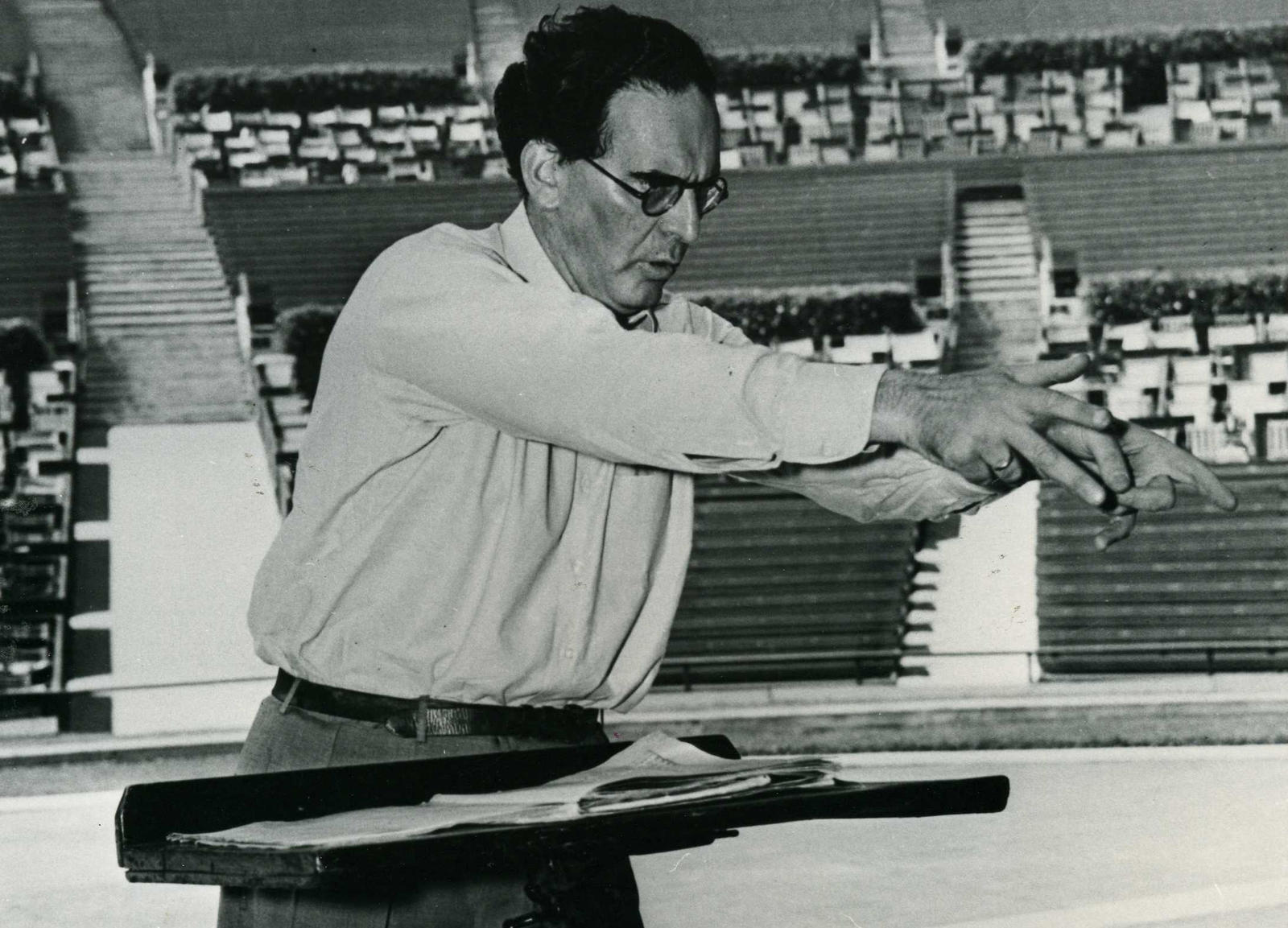
Rachmaninoff lends his hands

Russian composer and concert pianist Sergei Rachmaninoff, a frequent soloist in Los Angeles, makes his first appearance with the L.A. Philharmonic. Together they play the composer’s second piano concerto at Pantages Theatre.
At this point in his career, Rachmaninoff had announced his intent to retire from stage performance, but he would continue touring until his death in 1943.
First U.S. conductor signs on with the orchestra
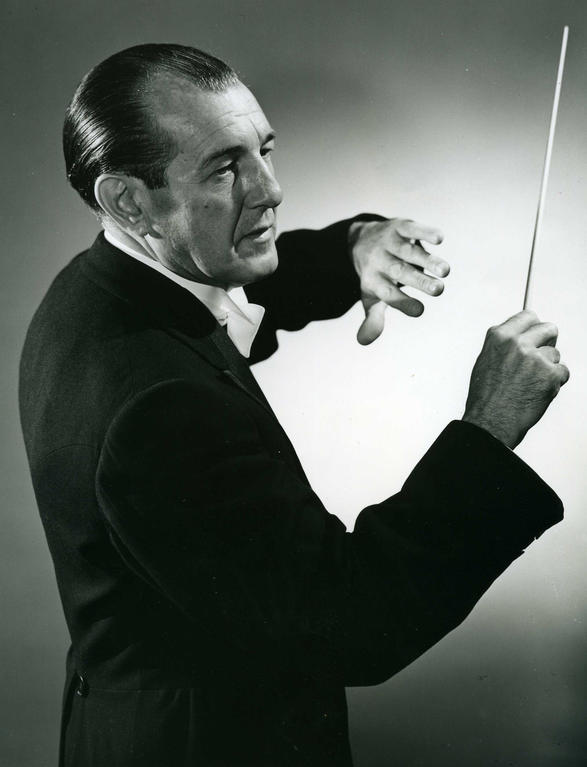
The Southern California Symphony Assn. announces that Alfred Wallenstein, the Philharmonic’s first American-born music director, has signed a three-year contract with the orchestra.
Wallenstein’s mission to present music to the masses brings stability and national recognition to the organization during his 13-year tenure. He creates "Symphonies for Youth" (a concert series integrated into the public school system), frequently holds concerts outside of the Philharmonic Auditorium and is an early advocate for putting classical music on the radio. Wallenstein leaves in 1956 to pursue other opportunities. Read the L.A. Times review of his first concert with the orchestra.
Fundraising powerhouse takes principal role
Dorothy Chandler, wife of then-L.A. Times publisher Norman Chandler, is elected as executive vice president of the Southern California Symphony Assn. She first stepped into the performing arts scene as chair of a committee tasked with reopening the Hollywood Bowl, which had closed the previous year because of financial difficulties.
Chandler would spearhead massive efforts to construct the Music Center, a new performing arts venue for the Philharmonic and the city.

Van Beinum arrives, humble and celebrated

Dutchman Eduard van Beinum arrives to guest-conduct the L.A. Phil, accepting the music director role two weeks later with modesty. “The best conductor is one the audiences forget and do not see,” he tells The Times.
Van Beinum’s reputation is backed by special honors and awards from four European countries, and his ongoing, 17-year tenure as permanent conductor of the highly ranked Royal Concertgebouw Orchestra of Amsterdam. Read the L.A. Times review of his first concert with the orchestra.
Van Beinum’s unexpected death

The excitement surrounding Eduard van Beinum turns to sorrow when he dies unexpectedly of a heart attack during a rehearsal with the Royal Concertgebouw Orchestra.
Van Beinum had expressed wishes to return to Los Angeles before his death (he was ordered to take a year’s leave of absence by his physician): “I hope Southern Californians will understand what a precious instrument they have and that everyone here takes care of it,” he said. “Keep it that way until I come back.”
Mehta, at 25, chosen to lead
Dorothy Chandler announces the young, Indian-born Zubin Mehta’s appointment as music director during the opening concert of the L.A. Phil’s 43rd season. The audience, familiar with Mehta’s charismatic stage presence as a guest conductor, breaks into cheers and applause at the news; musicians give a standing ovation.
At 25, Mehta is the youngest conductor to lead the Philharmonic as music director. Read the L.A. Times review of his first concert with the orchestra.

Full house celebrates Music Center opening

The official opening of the Music Center is hailed as the birth of a new era for music in Southern California. “This is the most unique city in the 20th century,” Zubin Mehta says to the audience after conducting Richard Strauss’ “Fanfare.” “I do not think it is too late now, in mid-century, to begin a new cultural life. This evening we are going to usher in a new era.”
One of the largest performing arts complexes in the nation, the Music Center soon hosts three venues: the Dorothy Chandler Pavilion, the Mark Taper Forum and Ahmanson Theatre. (Click here for our special coverage of the Music Center on its 50th anniversary.)

Fleischmann drives the orchestra forward
Ernest Fleischmann arrives from London, joining the Philharmonic as executive director. Fleischmann, who establishes a reputation of tough-minded leadership, will go on to double the musicians’ salaries and drive the creation of Disney Hall.

A 20th century flop, save for Zappa
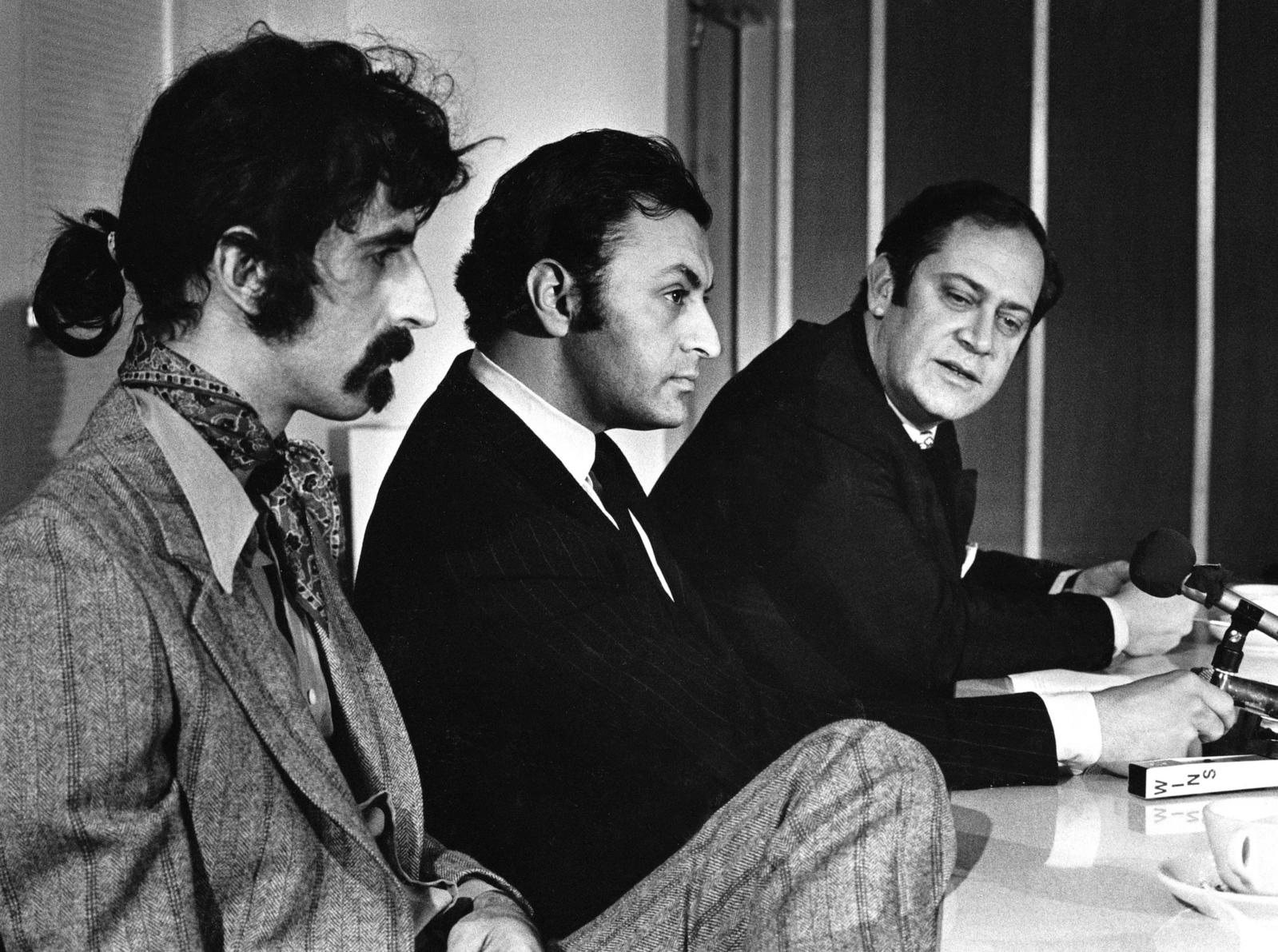
The L.A Phil turns its focus away from the past, premiering several 20th century works in the four-concert series “Contempo ’70,” including an orchestral piece by rock musician Frank Zappa titled “200 Motels.” Turnout is only fair (less than 2,000 on most nights), with the exception of the several thousand fans who showed to see Zappa.
Establishing a tradition of travel

The orchestra embarks on its Mediterranean cruise tour, stopping at Barcelona and Palma de Mallorca in Spain; Florence and Civitavecchia in Italy; Porto Carras and Athens in Greece; Madrid and Toledo in Spain.
After this trip, the L.A. Phil begins touring annually in the U.S. and abroad (with the exception of 1995, 2000, 2004, 2009).
Giulini colors the L.A. Philharmonic ‘Romantic’
Zubin Mehta introduces his successor, Carlo Maria Giulini, onstage during a ceremony at the Dorothy Chandler Pavillion. Giulini, 63, garners much adoration for his Romantic-era style and acute sensitivity to the score. (“He is an artist, a poet, a musician,” a member of the Philharmonic told The Times. “Playing for him is joy.”) The Italian conductor also brings along a contract with the distinguished classical record label Deutsche Grammophon. Read the L.A. Times review of his first concert with the orchestra.
Giulini retires in 1984.
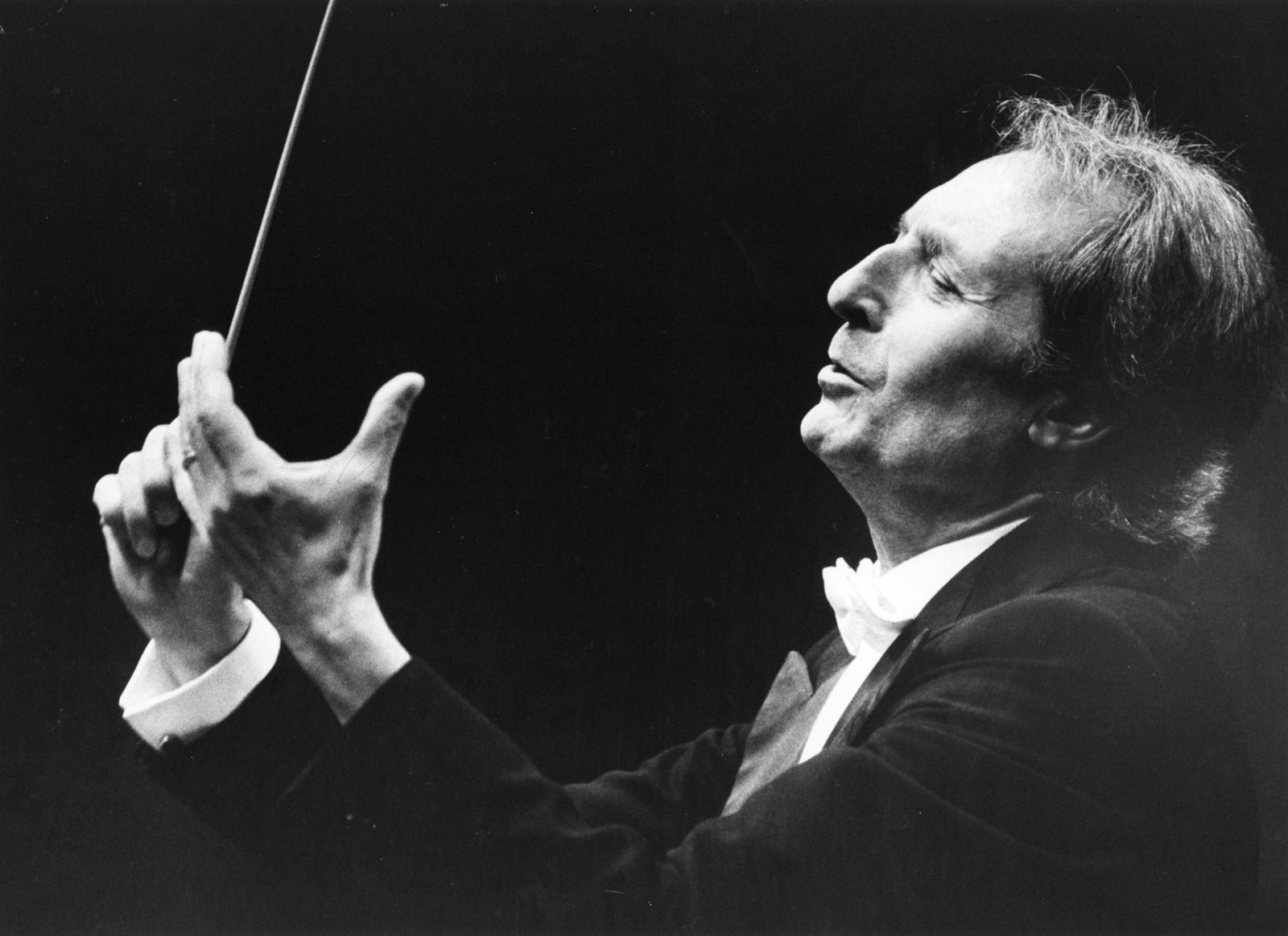
A Hollywood composer takes the reins
American conductor Andre Previn is named the orchestra’s next music director. “The close relationships that he has developed with members of great orchestras and the love and respect they have for him, make [him] a very special human being indeed,” Carlo Maria Giulini says about his replacement.
Although response to the four-time Oscar winner’s pending arrival is enthusiastic, audiences looking for the Hollywood glamour his experience suggests do not warm to his tasteful but serious conducting.

Walt Disney Concert Hall takes shape
Lillian Disney pledges a $50-million gift for the creation of the L.A. Philharmonic’s latest home, in honor of her late husband Walt Disney. In a statement, she says that the performance space is “an opportunity to honor him and to give something to Los Angeles which could be enjoyed by people of all walks of life."
The project, faced with various delays, would not be completed until 2003 (almost six years after Lillian’s death).
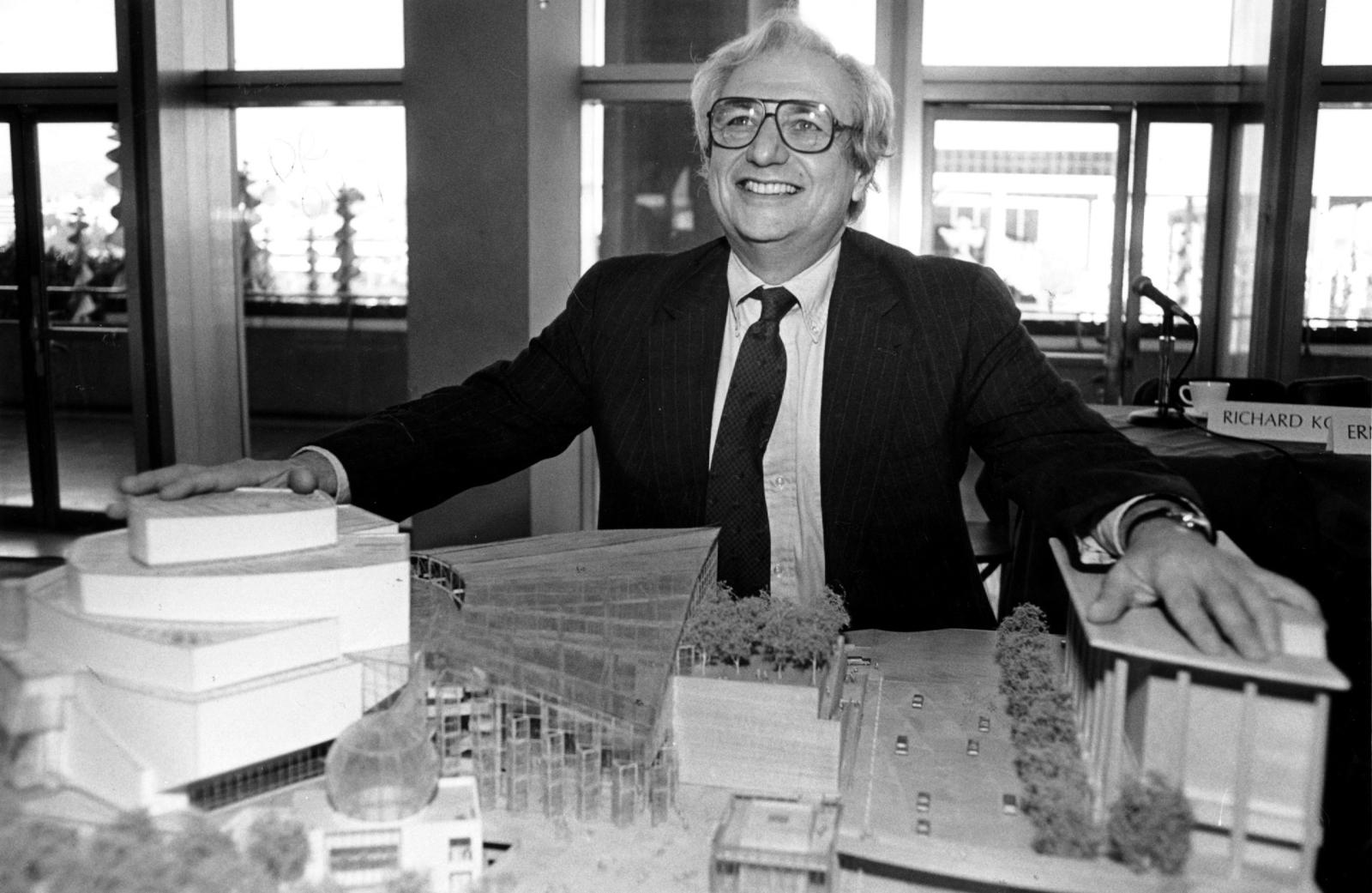
Previn wants out
Andre Previn announces his resignation after clashes with Ernest Fleischmann. "I have decided that, in the current structure of the Los Angeles Philharmonic," he says, "it has become obvious to me there is no room for a music director."
Fleischmann’s attempt to name Esa-Pekka Salonen (popular with the Philharmonic since their first concert together in November 1984) principal guest conductor without Previn’s knowledge caused the unmendable rift.

Drama aside, Salonen gets down to business

Finnish composer Esa-Pekka Salonen, 31, is chosen to be Andre Previn’s successor, a burst of youthful energy. His tenure officially begins in October 1992 and lasts 17 years – the longest term served at the L.A. Phil. Harboring a zeal for contemporary music, the “accidental conductor” will give 120 pieces their world or American debuts and commission over 54 new works. Read the L.A. Times review of his first concert with the orchestra.
High expectations set upon Fleischmann’s leave

Willem Wijnbergen picks up the managing director reins as Ernest Fleischmann, 73, officially retires. Despite having nurtured the L.A. Phil’s budget from about $5 million to almost $45 million, Fleischmann leaves at a time some call financially bleak for the orchestra.
"My attachment, my love for the Philharmonic remains," Fleischmann says. "If there are ways in which I can still be of use, I'll be delighted.” He will continue to work with the organization until his death in 2010.
Wijnbergen’s forced resignation
Willem Wijnbergen is relieved from his position after just 15 months, after sending a letter to the Philharmonic board regarding “serious issues” (no details were disclosed). Philharmonic Assn. President Barry Sanders says that the letter, which detailed Wijnbergen’s intention to terminate his contract if the issues were not addressed, was accepted as a resignation.

Deborah Borda shakes up the Philharmonic

New York Philharmonic Executive Director Deborah Borda is lured to Los Angeles as Willem Wijnbergen’s replacement. "We have a really special opportunity to shape what an orchestra will be like in the 21st century, not just for the nation, but for the world," she tells The Times.
Borda, who officially takes over in January 2000, doubles the orchestra’s budget and pushes the Walt Disney Concert Hall project to fruition.
Disney Hall officially opens
The L.A. Phil inaugurates Walt Disney Concert Hall with a three-night gala featuring Stravinsky’s “Rite of Spring” and John Adams' "The Dharma at Big Sur,” for electric violin and orchestra.
The orchestra’s new nest, acoustically, far surpasses the Dorothy Chandler Pavilion in clarity, range and richness. In the months before the celebration, L.A. Times music critic Mark Swed had written: “The question is no longer whether the hall can serve the musicians, but whether the musicians can serve the hall.”
Click below to see the fireworks that concluded the opening-night performance:
Video elevates Wagner

The L.A. Phil unveils its experimental “Tristan Project,” the three acts of Wagner’s “Tristan und Isolde” spread over a long weekend with Esa-Pekka Salonen’s soundscape, opera director Peter Sellars’ stage visions and artist Bill Viola’s video backdrops.
The production would be reprised in 2007.
Click below to listen to an excerpt from the 2004 performance:
Pulling an all-nighter with the Phil

The Los Angeles Philharmonic’s Minimal Jukebox concert series begins at 11:59 p.m. with an electronic music lineup featuring pioneers of ambient house the Orb and other local artists.
The two-week program, which includes a tribute to minimalist stars Steve Reich, Terry Riley and Philip Glass, brings a younger generation to Disney Hall. The festival will come back, bigger and better received, in 2014.
Click below to hear an the L.A. Phil play Movement 2 from Steve Reich's "Three Movements for Orchestra":
Salonen makes way for a successor

Esa-Pekka Salonen announces his retirement and introduces internationally watched conductor Gustavo Dudamel as his eventual replacement (to the chagrin of orchestras in other cities).
"Los Angeles was the first orchestra to give me the opportunity to make my U.S. debut at the very beginning of my career," the 26-year-old Dudamel tells The L.A. Times. "The energy was very special from the start, and I love how open to new ideas the orchestra is."
The Venezuelan first brought his agile and expressive conducting style to American soil in 2005 at the suggestion of Ernest Fleischmann and Salonen, jurors at the conducting competition Dudamel won in Bamberg, Germany, a year before.
Empowering youth through music
The L.A. Phil creates the Young Musicians Initiative, an attempt to bolster music education in the city. At its heart is the Youth Orchestra Los Angeles, or YOLA, a program that offers instruments, classes and concerts to disadvantaged children. YOLA mirrors the Venezuelan orchestral program El Sistema, which Gustavo Dudamel himself joined when he was 4.

New creative chair on the block

At 61, composer John Adams joins the orchestra as creative chair. News of the partnership accompanies the announcement of the orchestra’s 2009-10 season, which features the world premiere of Adams’ L.A. Phil commission “City Noir.”
"I wanted to write a piece that had a California sensibility to it,” Adams says about the Hollywood noir-inspired work. “We want to create a repertoire that speaks to our culture the way that Mahler's repertoire speaks for living in Central Europe around the turn of the 20th century."
Salonen sets down his baton
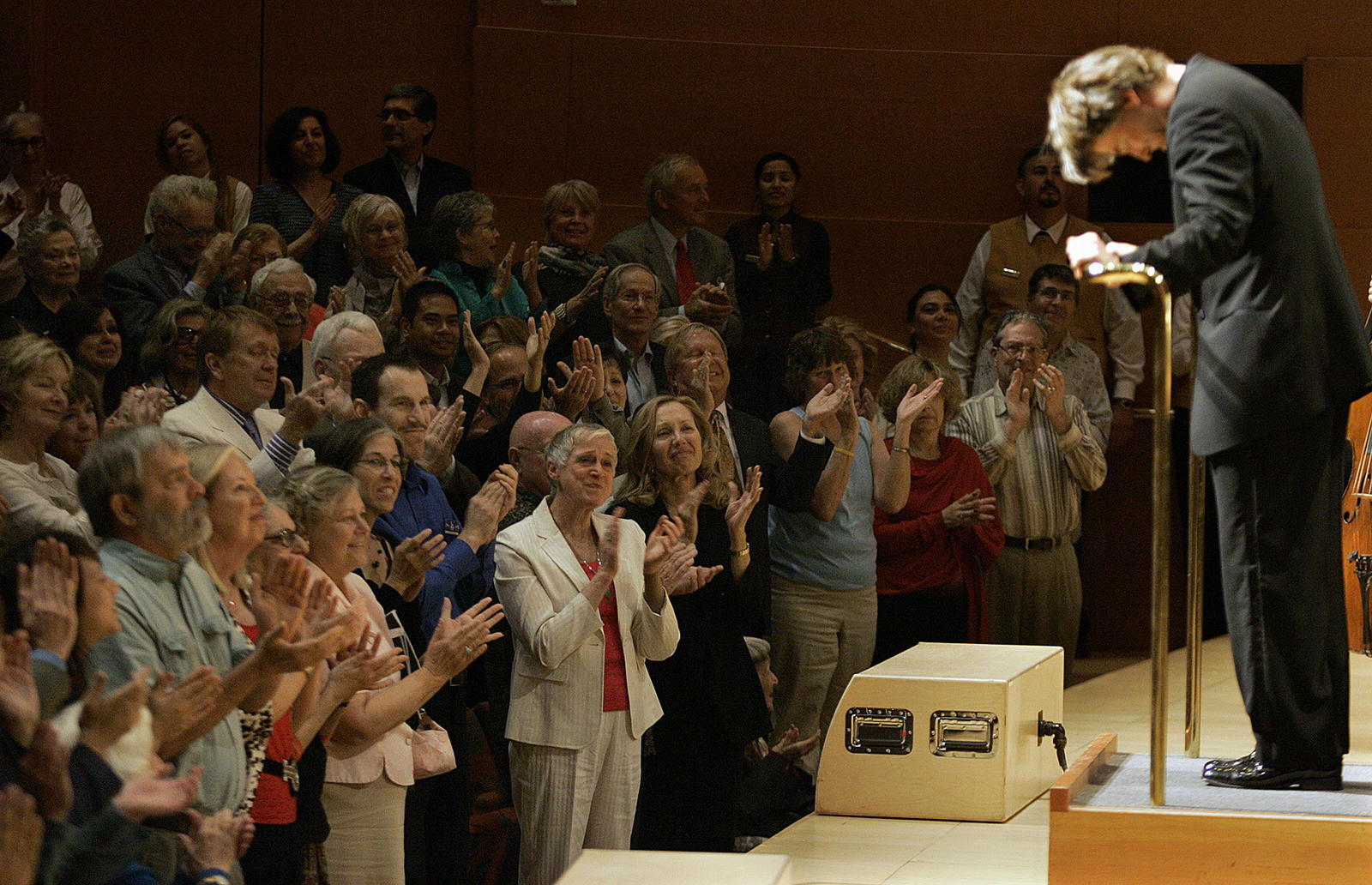
Conductor Esa-Pekka Salonen says goodbye with Stravinsky’s “Oedipus Rex” and “Symphony of Psalms.” Click below to hear an excerpt.
Salonen, applauded for more than 10 minutes at his last concert, is largely credited with turning the L.A. Philharmonic into a world-class orchestra. “I … wanted to create a modern concept for an institution that was already on a very high level," he explained, a year after the announcement of his leave. “I finally understood that what I have to do is create an identity for the orchestra that is typical of this place and time.”
Salonen, who became principal conductor of the Philharmonia Orchestra in London, was also named the orchestra’s first conductor laureate.
Dudamel embraces all with directing debut

Gustavo Dudamel premieres as music director with “¡Bienvenido Gustavo!” at the Hollywood Bowl. The free concert unfolds with a gamut of genres and players of many ages, ending with Beethoven’s Ninth Symphony and fireworks.
Dudamel’s first concert at Disney Hall in his new role follows five days later. See footage from that performance below:
Orchestra tries for pixel perfection

The L.A. Philharmonic begins “LA Phil Live,” broadcasting an afternoon performance live and in HD to about 450 movie theaters in the U.S. and Canada. The concert simulcasts, part of an ongoing mission to raise the orchestra’s global profile, are canceled after two seasons because of insufficient funds.
Mozart goes avant-garde
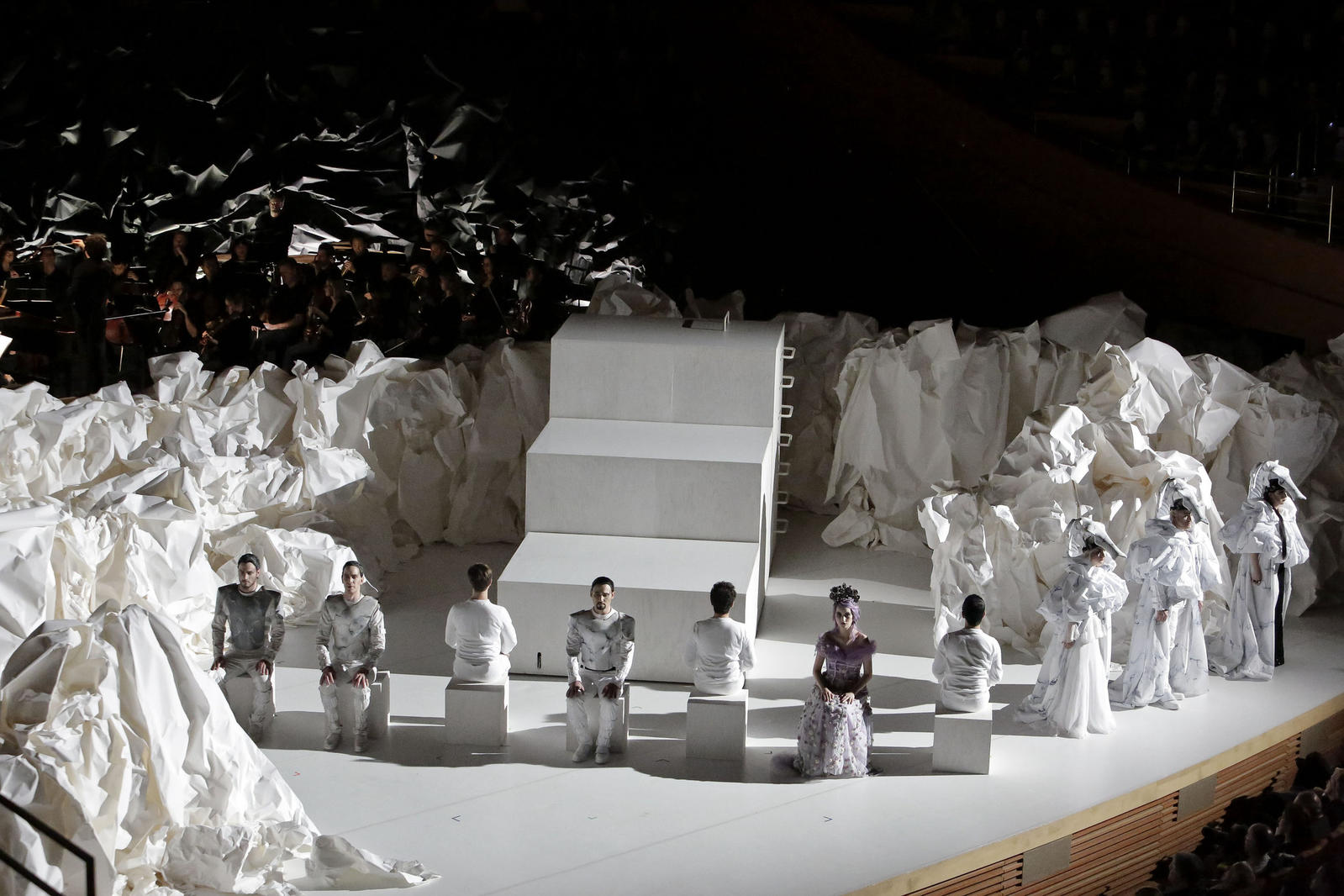
The L.A. Phil stages “Don Giovanni” with a modern twist, featuring crumpled, white set pieces by Frank Gehry and costumes by fashion brand Rodarte.
It is the first part of Dudamel’s three-year project spotlighting Mozart’s operas: In 2013, architect Jean Nouvel and fashion designer Azzedine Alaïa create a world for “The Marriage of Figaro." In 2014, Zaha Hadid Architects and Hussein Chalayan help imagine a 21st century “Così fan Tutte.”
Click below to hear an excerpt from the Philharmonic's 2012 production of "Don Giovanni":
Walt Disney Concert Hall turns 10
The orchestra commences its 10th anniversary celebration at Walt Disney Concert Hall with three free community concerts. The actual concert season begins with a gala featuring guest soloist Yo-Yo Ma, video installations and a program that helps tell the story of Gehry’s curvaceous venue — one that starts with John Cage’s “4’33” and ends with an orchestral arrangement of “When You Wish Upon a Star.”
“We can think, ‘In 100 years, what will [this hall be]?’ And I think this hall will be always young … it will be always full of energy, full of beauty, full of power,” reflects Gustavo Dudamel in the days before the performance.
Watch Dudamel's full interview with the L.A. Times below (click here for full anniversary coverage):